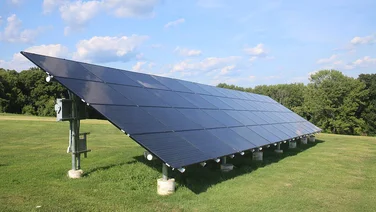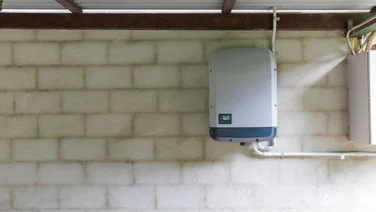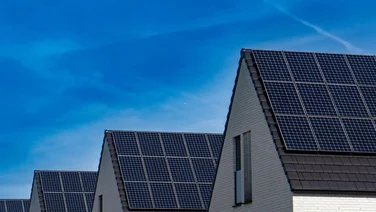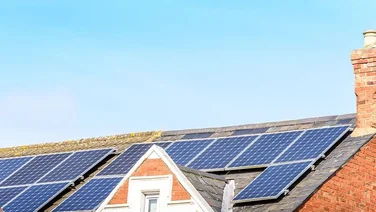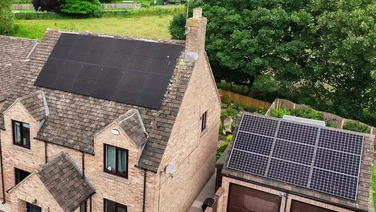- How much can I save by installing solar panels?
- What are the benefits of installing solar panels on a block of flats?
- What permissions do I need to install solar panels if I live in a flat?
- How are solar panels on a block of flats financed?
- Where is the best place to install solar panels on a block of flats?
- Installing solar panels on your wall
- Installing solar panels on your roof
- Installing solar panels on your balcony
- Having solar panels on your window
- Summary
- If you live in a flat, solar panels can reduce the amount of grid electricity you use by half
- Your ability to install solar panels will depend on the area you live in and the type of flat you own
- If you’re a tenant, you’ll need to ask your landlord for permission
- Funding is also available through government grants, such as ECO4 or through green loans from banks
- You don’t need permission to install a balcony solar panel

Solar panels are not just for houses. If you live in a flat, they can cut your energy bills and carbon emissions as well. According to the latest Ofgem figures, you can halve the amount of grid electricity you use and save £272 a year if you live in a two-bedroom flat.
In fact, flat owners can save £2,601 during the average lifespan of their solar panels, which is approximately 25 years.
However, flats are often left out of the solar panel discussion, as are renters. This is because getting permission to install panels for a flat can be complicated if you don’t own the entire block.
However, in this article, we’ll give a full guide on where you can install solar panels, the costs, the available government grants for solar panels and the benefits of installation. If you’re already clued up on solar panels in flats and are ready to proceed with installation, we can help.
Simply enter a few details in this short form, and we’ll put you in touch with local installers who’ll provide free, bespoke quotes.
How much can I save by installing solar panels?
Installing solar panels on flats has the potential to save you around 50% on your electricity bills, and 70% if you utilise grants for solar panels the Smart Export Guarantee (SEG), but more on that below.
With these savings in mind, based on Ofgem’s current electricity price per unit of 22.36, it will take an average 1-2 bedroom flat with six panels costing £4,215, 15.66 years to break even.
What’s more, if multiple flats share a solar panel system, it’s likely that more of the electricity produced by the panels will be used, instead of being sent back to the grid. This is because the electricity generated will likely be used more evenly throughout the day in a block of flats, since people will be using electricity at different times.
As a result, a block of flats, on average, sharing solar panels will consume around 80% of the electricity they generate, compared to 50% for the average detached house, according to Allume Energy.
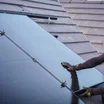
Get free solar panel quotes
Answer a few quick questions, and our trusted installers will send you bespoke solar panel quotes – for free.
What are the benefits of installing solar panels on a block of flats?
Still not convinced? Here are some reasons you should consider using solar panels to power your flat in 2025:
- Reduced costs — Installing solar panels will help you reduce your monthly energy bills, as you’ll reduce your dependence on the National Grid. You’ll still rely on it a little, unless you invest in a solar battery.
- Potential earnings — As it says above, if you own your flat, you may be able to make a profit of £2,601.07 during a solar panel’s 25-year lifespan, thanks to the government’s Smart Export Guarantee (SEG).
- Reduced carbon footprint — You’ll also reduce your carbon footprint and increase your property value. Solar panels have a long lifespan, so while it’s an expensive investment initially, the profit you’ll earn after 25 years makes it a worthwhile investment.
Yes, you can install solar panels if you rent a flat.
However, it is a bit more complicated than it would be if you lived in a house. This is because you can’t decide to make any changes to a whole block of flats on your own, unless you own the building.
Whether or not you can install solar panels will depend on the area you live in and the type of flat you own. Some local authorities and managing agents will allow you to install solar panels if you own the topmost flat. But if you own a middle – or ground – flat, you probably won’t be legally allowed to put solar panels on the roof.
Repowering London says you will need a licence for alteration to install any solar panels. This might cost a fee and you’ll need to talk to the freehold owner for details. If you rent, you will need to discuss installing solar panels with your landlord. Watch solar expert Ramin Hakimov talking about sharing solar power for flats on Positive Energy podcast – powered by The Eco Experts, below:
What permissions do I need to install solar panels if I live in a flat?
The type of permission you’ll need to install solar panels on a block of flats will depend on the following factors:
- Who owns the block of flats
- Where the block of flats is located
- Where you are planning to put the solar panels
- How big the solar panels are
- How many you want to install
If you’re a tenant, you’ll need to ask your landlord for permission – as previously mentioned – before installing solar panels. If you own a flat, but not the whole building, you will need to get permission from the relevant authorities, such as the building management company.
If you want to mount solar panels on the exterior of your block of flats, such as the roof or walls, you’ll need to check what restrictions apply within your local authority and whether planning permission is needed.
For example, if your block of flats is a listed building, you need to get Listed Building Consent, followed by planning permission before installation can take place. If your flat is in a conservation area, you need to contact your local council.
When implementing a shared solar panel system on your block of flats, you need to check if your neighbours own part of the roof. If they don’t and you’ve obtained all the relevant permissions, you don’t need their permission to install solar panels.
However, if you are planning on installing them, do let them know so they’re aware of any upcoming works to the building.
You might even be able to install solar panels on a council house, but you’ll need to check with your local authority to see if this is possible.

Get free solar panel quotes
Answer a few quick questions, and our trusted installers will send you bespoke solar panel quotes – for free.
How are solar panels on a block of flats financed?
Solar panels on flats are usually financed either collectively by the people who live in the individual flats or by a larger organisation.
In most cases, people who own the flats will each pay their share. But if solar panels are being installed in social housing, they’ll often be financed by the local council.
Funding is also available through government grants, such as the ECO4 scheme or through green loans from banks.
You can read more about all the available current solar panel grants through our guide: How to get UK grants and funding for solar panels
Homeowners can earn money from having solar panels on their flat through the government’s Smart Export Guarantee (SEG), which allows solar panel owners to sell the unused energy their panels generate back to the grid.
This means if the solar panels are being used to power your flat – whether you have a shared solar panel system or a private one – you can earn money through the SEG.
Where is the best place to install solar panels on a block of flats?
Here are four common places you should consider, alongside their pros and cons:
Installing solar panels on your wall
Pros: Convenient if you can’t install them on the roof.
Con: This isn’t always possible and isn’t great at producing energy.
Although wall-mounted solar panels installed at a parallel angle are easier to maintain than roof-mounted solar panels, they tend to produce less energy because they’re not usually exposed to as much sunlight.
If you own your property, you can even install solar panels on the ground next to the wall of a block of flats, using ground-mounted solar panels.
Single ground-mounted solar panels are considered permitted development, so they won’t typically require planning permission. Landowners will also be able to benefit from the SEG if they produce surplus energy using the ground-mounted panels.
However, if the panel is over 9 by 4 meters or will be located near a listed building, you will need to obtain approval from your local planning authority prior to installation. Renters may face additional challenges and will require explicit permission from their landlord.
Installing solar panels on your roof
Pros: These produce more energy than if they were on the wall.
Cons: It isn’t always possible to, especially if roof space is limited.
Rooftops on shared buildings are too small for flats to really benefit from solar panels. Also, the more flats there are in a block, the less roof space available to individual tenants to install a big enough solar panel system to power each flat.
The good news is that there are options out there, including Allume Energy’s SolShare solution. According to the solar panel installer, SolShare is the world’s only technology that can connect multiple flats to a single rooftop PV array and share it fairly between residents.
The technology can be a great option for buildings with limited roof space, as it bypasses the need for individual systems, which require more surface area to install.
It works by dynamically monitoring each flat’s energy demand, before allocating the exact kWh that each flat needs without exporting excess energy back to the grid. By leveraging a shared system, SolShare can generate as much or even more energy than individual houses, and also helps increase the Energy Performance Certificate (EPC) banding for flats.
The SolShare system costs between £2,500 and £5,000 per private flat and can be installed in social housing and on new builds.
Schemes such as SolShare aim to help reduce the bills of lower-income households. Social housing providers in the UK are able to work with Alternate Energy UK to access funding for these solar panels through government schemes like ECO4, if the flats meet the eligibility requirements.
In England, rented social housing made up 16.6% of homes in 2022, so more social housing with solar panels will also go towards reducing the UK’s emissions as a whole, without large investments from those who can’t afford it.
This can also be where community solar projects can help. This is because community solar projects allow multiple flats in the same building to access the electricity generated from roof solar panels, opening up the possibility of solar energy to any flat owner, not just the ones on the top floor.
We usually recommend placing your solar panels on a south-facing roof, at an angle of between 20 and 50 degrees instead. Your panels will then be exposed to more sunlight, which will generate more electricity for you.
There isn’t an issue if your roof is flat or steeper than 50 degrees, however. You will just need to invest an additional mounting frame system that will angle them the right way – although this will likely increase the overall cost.
There is also a chance it might not be possible, so check with your installer before investing.

Installing solar panels on your balcony
Pros: You can set it up yourself, and you don’t need permission.
Cons: They will produce less energy than they would if they were on your roof.
Installing solar panels on the balcony of your flat can be a quick and easy way to use solar energy. You don’t need permission to install a balcony solar panel, however, if you are renting, it’s best to inform your landlord of your plans.
You can usually set up a balcony solar panel yourself as it’s a small plug-in portable system, which comes with a portable solar-powered generator. These types of panels can easily move with you, which is a huge bonus if you’re renting.
The challenge is plug-in solar panels don’t often provide enough electricity to power an entire flat, but they can be used to power appliances, which would still lower your energy bill. The amount of power generated will depend on your system’s size and sun exposure.
A small UK flat will typically use around 1,800 kWh of electricity per year, and homeowners will need at least six panels to provide this level of electricity.

Having solar panels on your window
Pros: They are easy to install and you don’t need permission to use mini solar panels
Cons: Their energy-generating potential is quite low compared to having them on your roof
If you don’t have a balcony, you could also consider installing small solar panels or mini solar chargers on windows. These solutions will only be able to generate enough energy to power small devices such as smartphones and power banks, however.
Solar window technology is in development too, but it currently isn’t efficient enough to convert sunlight into energy. Another good alternative is solar shades, as they’re easy to install and are renter-friendly.
Summary
- To power a 1/2bedroom flat, you’ll need around six solar panels, which will take up around 12sqm. This will produce enough electricity to cover approximately 46% of your annual usage.
- How many solar panels and how much electricity you generate will depend on the size of your flat, the efficiency of your solar panels and the amount of sunlight your flat is exposed to.
- Solar panels for a flat can save 0.42 tonnes of CO2 per year and help reduce energy bills by £272 per year. They can also increase the value of your flat by around 2%, which equates to around £4,800 based on UK property averages.
- You can invest in community solar panels, which are mounted on the roof of a block of flats to supply electricity to multiple flats.
- If you aren’t able to obtain permission for solar panels, plug-in solar panels are an option, especially if you have a balcony.
- Let your neighbours know you’re going to install solar panels before you go ahead with an installation.


